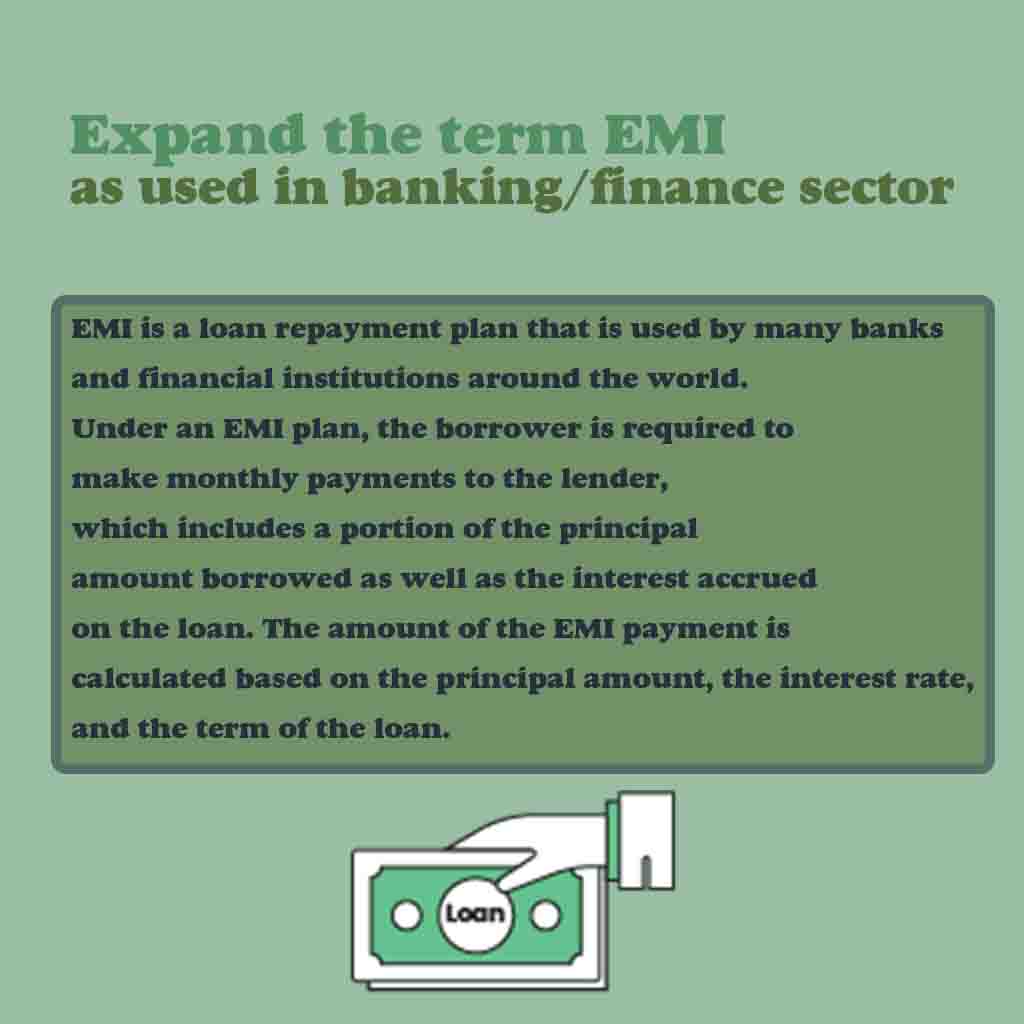
In the world of banking and finance, there are many acronyms and terms that can be confusing, especially to those who are new to the industry. One such term that you may have come across is EMI. EMI stands for Equated Monthly Installment, and it is a term that is used to describe a specific type of loan repayment plan. In this article, we will expand on the term EMI and explore its significance in the banking and finance sector.
EMI is a loan repayment plan that is used by many banks and financial institutions around the world. Under an EMI plan, the borrower is required to make monthly payments to the lender, which includes a portion of the principal amount borrowed as well as the interest accrued on the loan. The amount of the EMI payment is calculated based on the principal amount, the interest rate, and the term of the loan.
EMI is calculated using a formula that takes into account the principal amount, the interest rate, and the term of the loan. The formula is as follows:
EMI = [P x R x (1+R)^N] / [(1+R)^N-1]
Where P is the principal amount, R is the interest rate, and N is the number of months in the loan term.
For example, if you have taken out a loan of Rs 10,000 at an interest rate of 10% for a term of 3 years (or 36 months), your EMI payment would be calculated as follows:
EMI = [10,000 x 0.10 x (1+0.10)^36] / [(1+0.10)^36-1] = Rs 322.01
This means that you would be required to make a monthly payment of Rs 322.01 for 36 months to repay the loan.
EMI is an important concept in the banking and finance sector because it allows borrowers to plan their finances more effectively. By knowing the exact amount that they will need to pay each month, borrowers can budget accordingly and avoid any unexpected financial shocks. EMI also allows lenders to better manage their risk by ensuring that borrowers are able to make their monthly payments on time and in full.
In addition, EMI is a useful tool for comparing different loan products. By comparing the EMI payments for different loans, borrowers can determine which loan product is the most affordable and best suited to their needs.
EMI is an important term in the world of banking and finance, and it is an essential concept for both borrowers and lenders. By understanding how EMI is calculated and how it can be used to manage finances more effectively, individuals can make better-informed decisions when it comes to taking out loans and managing their finances.
EMI stands for Equated Monthly Installment.
EMI is a loan repayment plan used in banking and finance, where borrowers are required to make monthly payments to the lender that include a portion of the principal amount borrowed as well as the interest accrued on the loan.
EMI is calculated using a formula that takes into account the principal amount, the interest rate, and the term of the loan. The formula is: EMI = [P x R x (1+R)^N] / [(1+R)^N-1], where P is the principal amount, R is the interest rate, and N is the number of months in the loan term.
EMI is important because it allows borrowers to plan their finances more effectively, and helps lenders manage their risk by ensuring that borrowers make their monthly payments on time and in full. EMI also allows borrowers to compare different loan products and determine which one is the most affordable and best suited to their needs.
Yes, borrowers can prepay their EMI. However, some lenders may charge a prepayment penalty, so it is important to check with the lender beforehand.
If a borrower misses an EMI payment, the lender may charge a late payment fee or penalty. It could also negatively impact the borrower’s credit score and future creditworthiness.
In some cases, borrowers may be able to change the EMI amount by negotiating with the lender. However, this is not always possible, and changing the EMI may result in additional fees or penalties.
EMI is commonly used for personal loans, home loans, and car loans, among other types of loans.
This post was last modified on %s = human-readable time difference 8:39 pm
आज के डिजिटल युग में, छोटी-मोटी हिसाब-किताब का काम हमारे हर रोज के काम का हिस्सा बन चुका है। चाहे…
सुकन्या योजना में 14 वर्ष तक ₹250 जमा करेंगे तो 18 वर्ष में कितना मिलेगा? सुकन्या समृद्धि योजना (SSY) भारतीय…
How to whitelist morpho device How to whitelist morpho device : Morpho Device का उपयोग करने के लिए Device को Whitelist…
How to cancel Jio recharge and get refund? Jio is one of the largest mobile network operators in India, providing…
Amazon Franchise Kaise Le? Duniya bhar mein online shopping ka trend tezi se badh raha hai, aur Amazon jaise e-commerce…
In today's fast-paced world, where convenience and accessibility are paramount, it's no surprise that financial services have also evolved to…